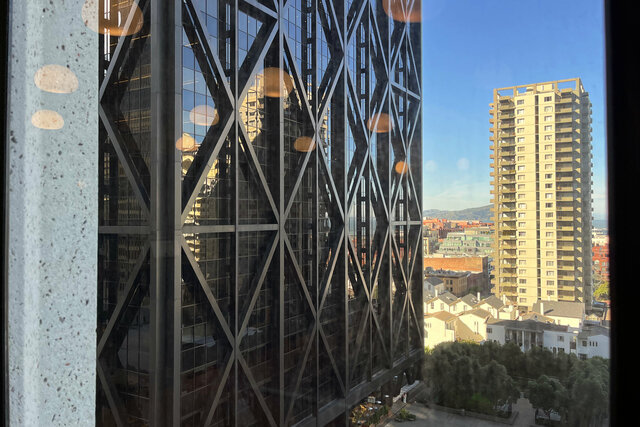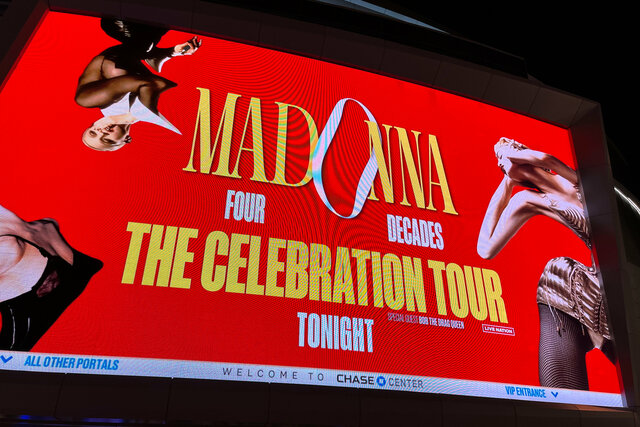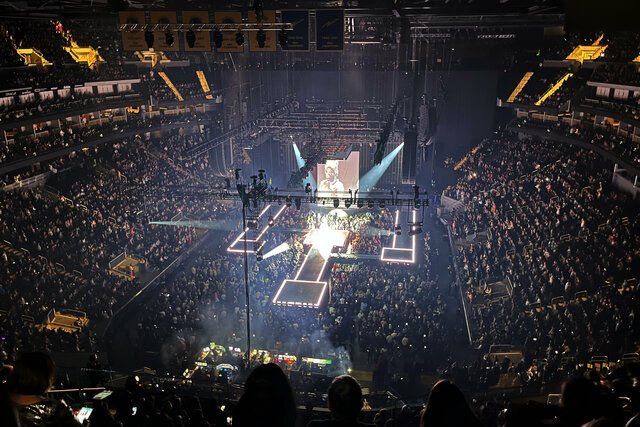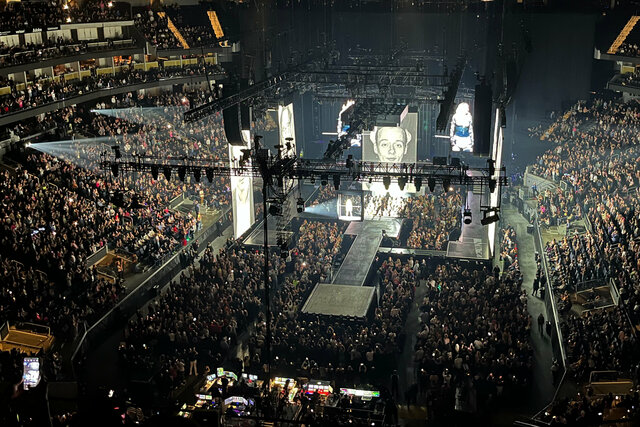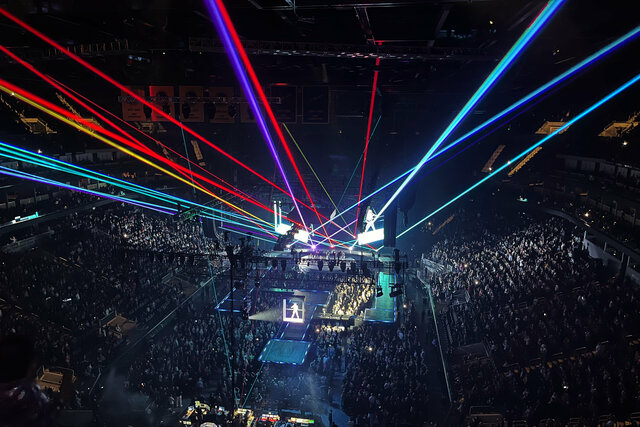Celebration
Started: 2024-03-02 22:32:45
Submitted: 2024-03-03 19:47:15
Visibility: World-readable
Madonna's Celebration tour in San Francisco
Like anyone growing up in the 1980s and 1990s I was aware of the existence of the pop star Madonna, and her provocative antics placing herself in the center of attention, earning the scorn of the conservative circles I grew up in. I didn't really listen to much of her music until I bought her 1998 album Ray of Light — an album that's still one of my favorites.
Madonna had been scheduled to come to San Francisco for two nights on her Celebration Tour in the fall of 2023, before the shows were rescheduled for January when the artist was hospitalized, then rescheduled again due to a scheduling conflict. By the time I got around to buying my ticket the shows had settled on their final dates in the middle of the week at the end of February. I picked the show on Wednesday, the 28th of February.
Only in the last several weeks before the show did I start listening to Madonna's back catalog in earnest. I found an Apple Music playlist that identified itself as the setlist from the tour, which seemed like a reasonable place to start; I also listened to the top songs on Apple Music and the essentials playlist. Many of Madonna's best-known songs were recorded in the 1980s, and most of them sounded like they belonged in that decade. The bassline for the original studio recording for "Like a Prayer", released in 1989, was the most obvious example; the bassline in the chorus sounded to me like like "bwang-bwang" and it should have been left in the 1980s, a big contrast against the choral backing to the verses. I wondered how much of the production would be updated to modern standards, when it was being performed for a live audience in 2024; and then I noticed that the very same song on the greatest-hits album The Immaculate Collection, released the next year in 1990, reengineered the recording to smooth the sharp edges off the bassline.
The show was on a Wednesday night, in the middle of the week, so I decided to work from San Francisco for the day, then get a hotel room in the city so I didn't have to drive back home (down the peninsula and over the mountain) whenever the show got out. I got an on-demand desk on the WeWork office on the eighth floor of Embarcadero Center 2, giving me an excuse to explore the Brutalist masterpiece stretching inland from the Ferry Building at the corner of the Financial District. The open-plan desks were located on the north side of the building; from my desk I was perched directly above the plaza in front of One Maritime Plaza, giving me a new view of the distinctive diagonal cross-bracing visible in the exterior skin, an example of engineering details being promoted to a design aesthetic, as long as I didn't look straight down to the plaza below.
(Someday I need to book an on-demand desk at WeWork on the 30th floor of Salesforce Tower, ideally before WeWork collapses entirely into bankruptcy and abandons its lease in San Francisco's tallest building.)
I ate a dosa for supper at Udupi Palace in the Mission, then caught a crowded #22 bus lumbering east along 16th Street to Chase Center in Mission Bay. The closer we got to the arena the more people were obviously heading for the Madonna show: dressed up to various degrees in flamboyant clothing, with a look of excitement about the show. One person was wearing a pink boa. At one point someone started playing a Madonna song on the speaker on their phone. We got out around the corner from the arena and walked across Third Street to reach the arena, lit up with a huge screen several stories tall on the side of the arena announcing the show we had come to see.
By the time I made my way into the arena the opening DJ was playing a set, standing behind a console in the middle of the stage in the middle of the arena while the audience listened politely, waiting for the show's headline artist. I found my seat, accessed by an upper concourse at the back of the arena. I sat in section 212, row 13, seat 8; and only when I reached my seat did I realize that my view of the stage was significantly obstructed by the lighting and equipment gantries suspended from the ceiling.
The DJ left the stage by 21:30 and waited for Madonna while the arena began to fill up. Eventually the music swelled and the lights dimmed, and special guest Bob the Drag Queen took to the floor of the arena in a fabulous dress with a huge bustle (and maybe wearing stilts, given how much taller she was than everyone else) and worked the crowd, talking to audience members before climbing onto the stage in the middle of the arena to set the stage and introduce Madonna.
Madonna took the main stage to sing the opening song, "Nothing Really Matters", dressed in an elaborate shiny black costume with a crown or halo behind her head, on an elevated rotating portion of the stage. The quality of the audio and the mix was good (even at the back of the arena), but the gantries above the audience obstructed my view of the main stage and the three large screens at the front of the stage projecting live video of the action on stage.
The show presented a selection of Madonna's songs from across her career (I guess it was her eras tour) sort of telling the story starting with Madonna showing up in New York in 1978 with $35 in her pocket (this part was in the script, spoken by Bob the Drag Queen before she threw cash into the audience).
Some of the songs were staged on portions of the stage that projected out into the audience on the floor of the arena. Backup dancers in various costumes climbed onto and off the stages, and each of the four larger platforms on the floor had stage lifts that allowed performers and props (including at one point a grand piano large enough for Madonna to dramatically drape herself across) to appear and disappear while my attention was directed elsewhere. From where I sat I could look down into the trap doors and occasionally see the performers crawling off of the stage lifts.
The music for "Like a Prayer" more closely resembled the more-restrained 1990 arrangement than the very-eighties bassline of the 1989 original. The staging extended the elevated rotating part of the main stage into a tall open cylinder, supported by pillars around the edges, with backup dancers performing acrobatics suspended between the pillars while Madonna stalked the inside of the rotating stage, keeping pace in the opposite direction of the rotation so she stayed in the same relative position to the audience.
For the song "Live to Tell", Madonna sang from a box suspended above the crowd on the floor of the arena, supported by a series of gantries and motors that gave the box a full range of motion in three dimensions above the arena. (I briefly flashed back to using linear stages to build motion-control systems in my first job. Then I wondered what kind of insurance riders the show needed to handle the risk to Madonna in the elevated box, and the risk that the box would pose to the audience.) The screens showed people who died of AIDS, but I didn't get the full impact because I couldn't see the screens very well.
The show went on for about two-and-a-half hours, with multiple costume changes (corresponding roughly to "acts", that kind of matched eras in Madonna's career, though if they were trying to tell a story I lost it by the second act). Where her costume allowed, Madonna wore a knee brace while she danced and strutted and gyrated on stage.
One of the last songs in the show, shortly before midnight, was "Ray of Light", one of my favorites (and the title track from the one Madonna album I own). For the previous song part of the stage furthest out in the audience had been elevated high above the floor, and Madonna sang lying down on the top of the cube, visible to much of the audience only through the video projected on the screens at the front of the arena. The floating box returned to the sky and picked up Madonna from the top of the cube (with a brief moment for the backup dancer to clip her into the safety tether at the back of the box), then the box took off into the sky for "Ray of Light", with the backup dancer gyrating on the top of the cube that had grown out of the stage.
And then, after a few more songs, Madonna sang her final song, thanked the audience, and left the stage, a few minutes after midnight. We applauded and cheered, the screams of her adoring fans echoing off the cavernous interior of the arena. The audience hung suspended there for a beat, wondering whether the show was over or whether there would be an encore. We had heard the last songs on the set lists I had seen, and then the house lights came up and we began to shuffle out of the auditorium.
As I followed the crowd down the steep arena seats and out the portal and onto the main concourse, and then out a series of exit doors into a large stairway to descend multiple flights of stairs to the plaza level, I began to wonder about my route back to my hotel in Union Square. Chase Center is right on the T-Third Street MUNI metro line, which now goes straight into the Central Subway past Union Square, but it was after midnight and that's when San Francisco's transit system starts shutting down. On my phone, Google Maps didn't think there would be any T line service until the next morning, but thought maybe I could catch a bus (or walk, it'd only take 40 minutes). I crossed the plaza in front of the arena (dodging vendors selling merchandise and hot dogs) and saw a crowd of people crossing Third Street to the lightrail stop in the median, where it turned out there were a couple of MUNI trains already waiting, apparently positioned there waiting for us to take them. I caught the train back to Union Square for the rest of the night.
I had seen Madonna perform a great show with ten thousand other people, and I was not going to forget it.

